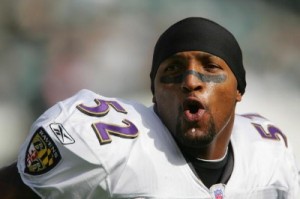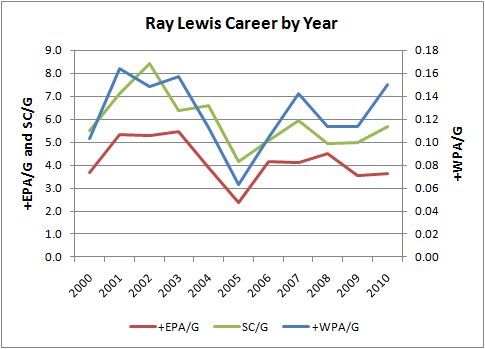
15 year League veteran Baltimore Ravens Ray Lewis Looking Spry As Ever.
Already in the league 34 years, Baltimore Ravens Ray Lewis says the signing of Nose Tackle Haloti Ngata to a long term (5 year 61 million!) deal makes him want to play longer for the Ravens. I don’t know how much “longer” is but let’s look at some long careers shall we?
New Orleans Saints Kicker John Kasay has currently been in the league 21 years. Kicker is not such a dangerous position though so that’s either amazing or not-so-amazing. Can’t really say. But 21 years is a long time to do any one thing if you ask me. Even kicking with the way they get fired at the drop of a dime (or bad kick). So for this year Kasay is a strong 5 for 5.
I believe George Blanda still holds the record for longest NFL career at 26 years. He was both a quarterback AND a placekicker. My how the league has changed, can you see Tom Brady kicking one in?
Many offensive lineman last 12 years or more. But not many linebackers make it past that 10 year mark for reasons I think are pretty obvious. When one group of researchers looked at player longevity they, of course, found a strong correlation between position and longevity.
For the 2008 NFL season, 39 percent of the 2004 Combine players were still active. For 1,889 players listed on 32 NFL team rosters, the average longevity was 4.6 years, with only 7 percent of players having experience in the league beyond 10 years. Four of five players with the greatest longevity (>18 yr) were punters or kickers (the other, a rare quarterback).
From these data, the research team discovered orthopedic or health-related factors were not as relevant in predicting longevity. The more prominent factor was where on the field these athletes played.
Specifically, the injuries associated with position showed the strongest link to overall career longevity. Injury locations and diagnoses were shaped by position; for example, offensive lineman had more back and neck injuries while linebackers experienced more shoulder injuries. Most injuries were at the shoulder and knee, with the lower back, neck, foot and ankle also common sites of players’ injury history. Tears were the most common type of injury, followed by dislocations, trauma, fractures and sprains.
With the way Lewis plays, you have to wonder if it’s one of those “Death Becomes Her” situations where Lewis has some serum that keeps him forever young and virile. Something is going on here and I want answers (so I can copy the paper)! I think one thing that worries me about Lewis is that I fear he may be one of those guys that is strong as long as he’s playing and begins to deteriorate pretty quickly the minute he’s done. I hope that’s not the case, I know he keeps one of the toughest off season workout regimens there is and I’m hopeful that we have this big guy around for a long time. Can you imagine his Hall of Fame speech?
In case you’re wondering just how productive Lewis has been, Advanced NFL Stats took a look recently.
The graph is plotted on 2 different axes. The red line is +EPA/G and the green line is SC/G, both of which are plotted with the primary (left) vertical axis. The blue line is +WPA/G and is plotted on the secondary (right) axis.
If the graph ended at 2005, you’d think that Lewis was in the twilight of his career, but he’s been making plays at a very high level since. He peaked somewhere between ’01 and ’03, but there’s been no lasting decline to speak of.
I think this graph probably speaks to Lewis’ comment about Ngata. The stronger the players around him, the better he is able to do his job. He’s not a young guy that can clean up problems for other guys anymore. In order to perform at a high level he needs others to know and perform their jobs well (I think this really applies to any job!). And as long as he surrounded by talent, there’s probably a starting spot for him on the Ravens roster for the next couple years.
And seriously, how crazy is it to have your dad play football in the NFL while YOU’RE playing in high school.











